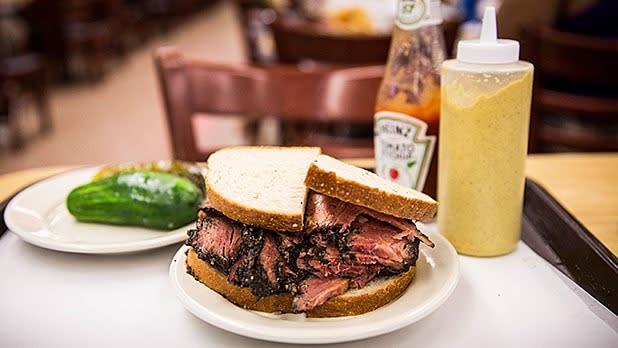How to Make Pastrami from Scratch

A pastrami on rye sandwich from Katz’s Deli in New York City. Photo: Andrew Burton / Getty Images
By Aly Walansky
Pastrami on club with spicy mustard may be the ultimate comfort food. It seems indulgent and simply delicious — but most of us probably have no clue how many hours of preparation go into that plate. And if you don’t live that close to Katz’s or Canter’s, getting a truly great pastrami sandwich might be truly difficult.
If you want to make your own pastrami for lunch, however, you’d better plan of getting out of bed before the sun comes up. “You’ve got to start it early to cure the meat, says Aaron Dreilinger, executive chef at Chef David Schwadron Catering and Event Design, one of the select vendors at Temple House (thetemplehouse.com), a former synagogue turned exclusive event venue on Miami Beach.
Related: The 50 Best Sandwiches in America
Old School Cooking
True pastrami is a labor of love. Pastrami is traditionally brisket that is cured, rubbed, smoked, brined, and roasted. "When the method was developed, it was a way to take less flavorful and tough cuts and elevate them to something truly special. Some chefs cure and brine for several weeks before the smoking and roasting process even begin! This recipe is a quicker version, with similar results,” says Dreilinger.
The Cure
The first thing to do is cure the meat. “Trim the fat off the outer parts of the brisket. Coat the meat with one part sugar, one part kosher salt. Let the meat sit in the basic rub for 24 hours. This draws out the moisture in the meat, and tenderizes it,” says Dreilinger. “Since traditional pickling salts are nitrite-based, we’ll be skipping that step. The salt-and-sugar rub achieve a similar result. After a day or so, the meat is washed," says Dreilinger. Don’t worry about getting all the sugar out. The roasting process will absorb the rest.
Related: 9 Pro Tips for Making Brisket
The Spice Mix
This part is key, especially if building a smoker isn’t in your near future. "Some great smoked spices are available on the market now for use at home. Some of the best are smoked salts and smoked paprika. One good tip is to grind your own. If you have an electric coffee grinder, that’s your best bet. If not, a Ziploc baggy and the business end of a spoon will do the trick. Blend coriander, smoked paprika, chili flakes, coarse cracked pepper, sweet paprika, granulated garlic, onion powder, and smoked salt. Now paint the meat with a layer of deli mustard to act like a glue for the spice mix. Don’t be shy with the spices. A good quarter-inch layer will do — in fact, pack it into the meat on all sides until it starts to fall off (and then add a little more!). I like to grind the spices in large batches, a quart or two at a time. It keeps well for the next round, and also goes great with grilled fish,” says Dreilinger.
Related: How To Utilize The Spices You Never Use
Low and Slow
Once your brisket has had some time to take in the salt and spices, it’s time to fire it up. “In a smoking hot pan, sear the meat on all sides. Cast iron is great for this, but any pan will do. Searing the spice will give it that smoked flavor that we want, as well as lock in the flavor for the next step. In a deep pan, place the brisket, fat side up, in the oven. Make sure that the pan is at least an inch deep to allow for the fat to cook off. An average cut of brisket of about 8 pounds is going to take about 8 hours! Its ok to wait until the next morning if timing is an issue here. Low means 225 degrees,” says Dreilinger. Slow and low temperatures brings out maximum flavor in the meat and lets all those steps we took to get to this point really take effect.
Slice it right
Best to let pastrami rest for at least another half an hour before cutting. And here’s the most important part — cut it right! “All meats have what we call a "grain" or the direction that the fibers of the meat run. Always cut "against the grain” so that the meat is as tender as possible,“ says Dreilinger. By now the meat has shrunk to about half of its original size, as most of the fat and excess moisture has left it. We are left with a tender, smoky, sweet meal.
Related: The 10 Best Beef Jerky Recipes
Serving
There are lots of great applications for our pastrami. Classically this is sliced thin and served with seeded rye, of course. But the peppery sweetness is great with kale and sweet potato. It also lends well to Asian flavors like soba noodles or Pad Thai.
"My favorite is a shaved fennel Asian slaw. Shaved fennel has a sweet crisp quality that pairs so well with beef. In a bowl, mix the slaw dressing. This recipe uses orange juice as a healthy base for the dressing. Thinly slice fennel, carrot, and kale. Make sure to remove the stems from the kale, only using the leafy portions. Toss with the dressing. This will keep in the refrigerator for a few hours while the flavors mix,” says Dreilinger.
But seriously, you only need some rye bread and some mustard for this meat. That’s it.
Everything You Need for Dreilinger’s Classic Pastrami Recipe
8 lbs of brisket
½ cup deli mustard
Rub:
2 cups sugar
2 cups kosher salt
Spice blend:
2 tbsp coriander
1 tbsp kosher salt
4 tbsp smoked paprika
2 tbsp sweet paprika
¼ cup cracked pepper
2 tbsp granulated garlic
2 tbsp onion powder
More from Men’s Journal:
You’re Salting Your Food All Wrong
12 Ways to Make Better Sandwiches
